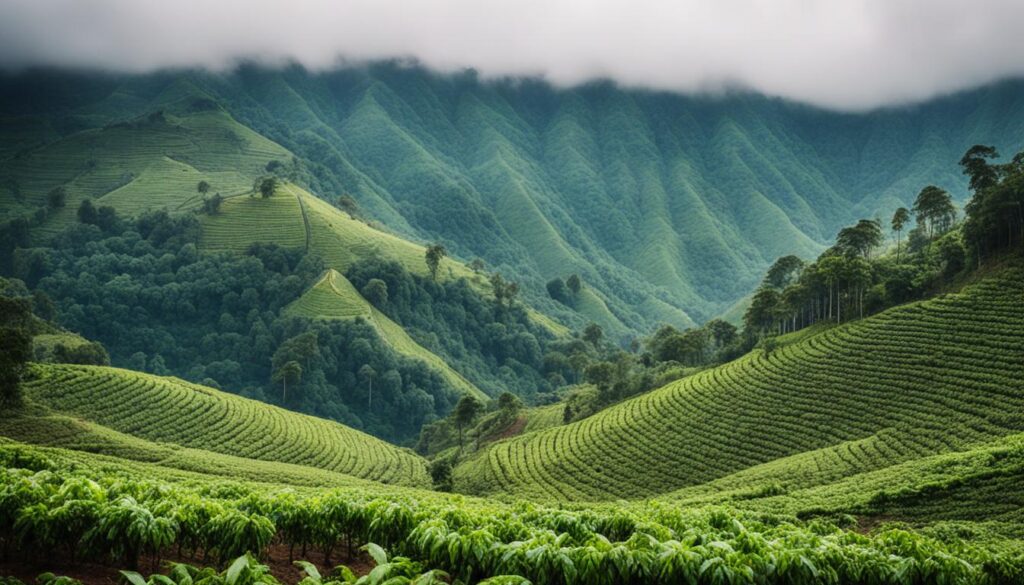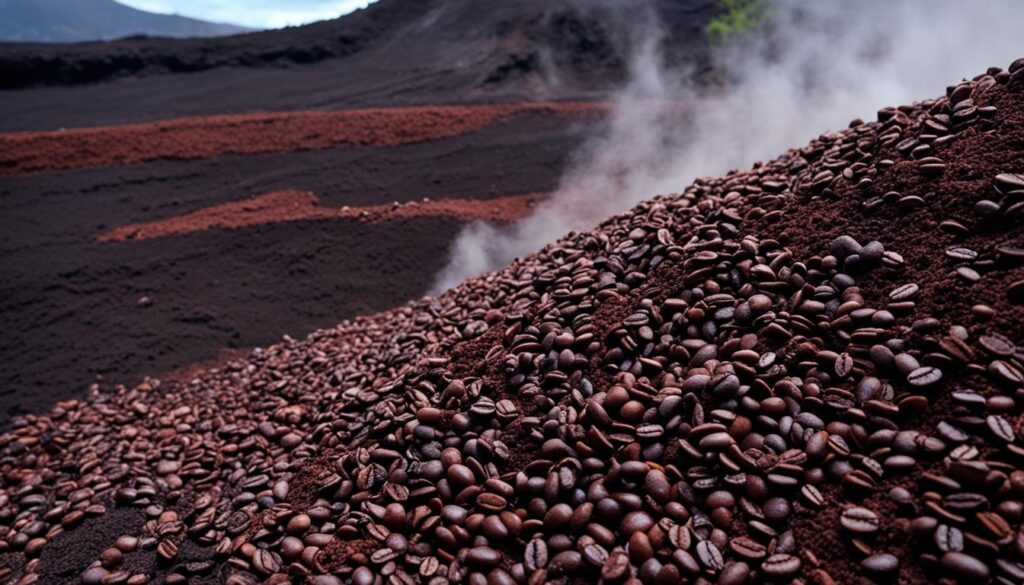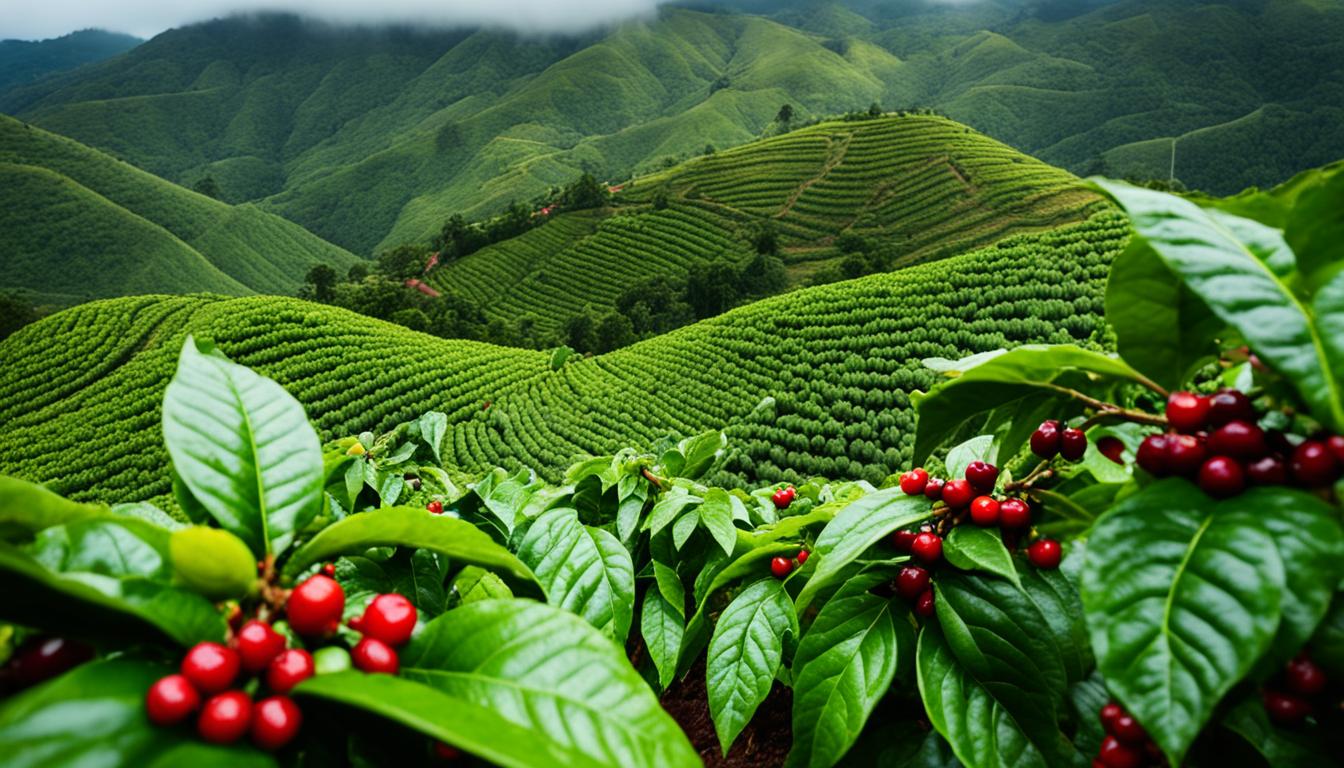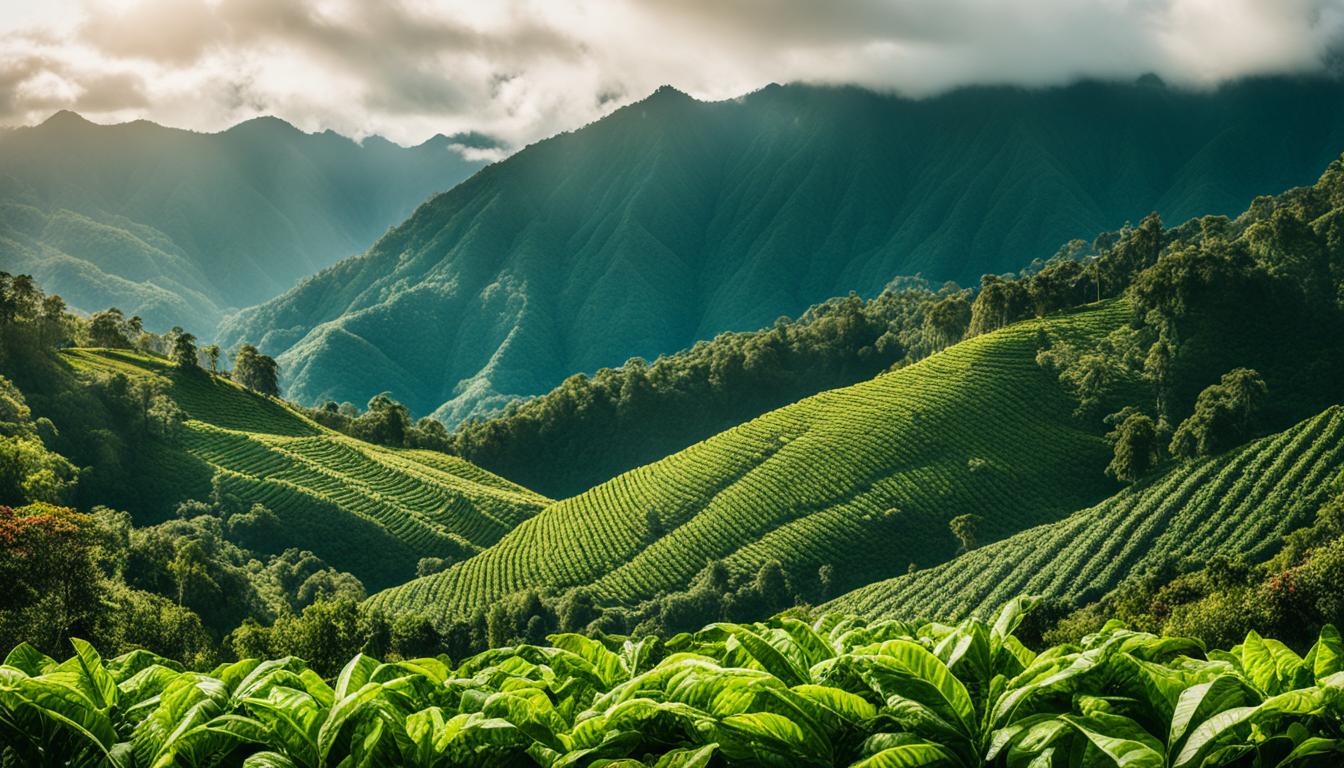Welcome to our exploration of the fascinating world of altitude and its impact on coffee beans. Did you know that elevation plays a crucial role in the size, shape, and taste of coffee beans? It’s true! Different elevations have a significant effect on the physical characteristics and flavor profile of your favorite brew. In this article, we will uncover the secrets behind altitude-grown coffee and how it elevates your coffee experience.
Key Takeaways:
- Altitude affects the size, density, and fissure line of coffee beans.
- Higher elevation coffee beans, known as strictly hard beans, have a more dense structure and result in a more flavorful cup of coffee.
- Higher altitude coffee is sought after for its exceptional taste characterized by acidity, aroma, and flavor complexity.
- Countries such as Guatemala, Ethiopia, Colombia, and Kenya are known for producing high-altitude specialty coffees.
- Understanding the importance of elevation can help you find your preferred coffee flavor profile.
Why Is Elevation Important in Coffee?
When it comes to coffee, elevation plays a crucial role in determining the size, shape, and taste of the beans. The altitude at which coffee is grown directly impacts its flavor profile, making it a key factor in coffee production.
Arabica coffee, which is known for its high-quality flavor, prefers to be cultivated at higher altitudes ranging from 1,800 to 6,300 feet. These elevated regions often have cooler climates, which are ideal for the growth and development of the Arabica bean. On the other hand, robusta coffee thrives at lower elevations of 600 to 2,400 feet with warmer climates.
The elevation of the coffee plantation affects the physical characteristics of the beans, such as density, fissure line, and color. Coffee beans grown at higher altitudes tend to be denser, resulting in a more concentrated and flavorful cup of coffee. These beans have a closed fissure line, allowing for a more even extraction during brewing.
Conversely, lower elevation coffee beans are generally less dense and have a semi-open fissure. This can lead to a less pronounced and more mild flavor profile. Understanding the importance of elevation can help coffee enthusiasts find their preferred coffee flavor.
Let’s take a closer look at the impact of elevation on coffee bean size:
| Altitude | Coffee Bean Size |
|---|---|
| High | Larger |
| Low | Smaller |
Note: The altitude at which coffee is grown directly affects the size, shape, and flavor of the beans. Higher elevation coffee beans are generally larger in size compared to their lower elevation counterparts.
By grasping the significance of elevation in coffee, we can appreciate the various flavor profiles and characteristics that different altitudes offer. Whether you prefer a rich and full-bodied coffee from high-altitude regions or a milder cup from lower altitude areas, elevation is a defining factor in the world of coffee.
How Altitude Affects Coffee Flavor
Altitude plays a crucial role in shaping the flavor of coffee. At higher altitudes, coffee tends to be more acidic, aromatic, and flavorful, while lower altitude coffee may lack character and acidity. This is because the cooler temperatures and slower growth at higher elevations allow the coffee cherries to develop more complex sugars, resulting in deeper flavors.
“Higher altitude coffee tends to be more acidic, aromatic, and flavorful, while lower altitude coffee is usually less acidic with little character in the cup.”
The drainage in high-altitude regions also reduces the water content in the fruit, further concentrating the flavor. The combination of ideal growing conditions and a longer maturation process at higher altitudes leads to the production of coffee with nuanced flavors, such as citrus, vanilla, cacao, or dark chocolate notes.
“The combination of ideal growing conditions and longer maturation process at higher altitudes leads to the production of coffee with nuanced flavors.”
“The combination of ideal growing conditions and a longer maturation process at higher altitudes leads to the production of coffee with nuanced flavors, such as citrus, vanilla, cacao, or dark chocolate notes.”
So, the next time you take a sip of your favorite cup of coffee, think about the altitude at which those beans were grown. It’s one of the key factors that contribute to the taste and complexity of your brew.
Altitude and Coffee Growing Regions
The world’s truly great Arabica coffees are predominantly grown in mountainous regions of the Coffee Belt, which is a tropical band extending approximately 30 degrees north and south of the equator. Central and South America, southern Asia, some Pacific islands, and mid to southern Africa represent the foremost coffee growing regions.
These regions offer a diverse range of altitude coffee regions suitable for cultivating high-quality beans. Altitude plays a crucial role in the flavor profile of coffee and is an essential factor in determining the specialty nature of certain beans. High altitude regions between 900m to 1500m and beyond provide the ideal growing conditions for coffee, including a frost-free climate, moderate rainfall, and abundant sunshine.
Top Coffee Growing Countries by Altitude
Here’s a list of coffee growing countries known for their high-altitude specialty coffees:
- Java, Indonesia
- Sumatra, Indonesia
- Nicaragua
- Mexico
- Costa Rica
- Kenya
- Ethiopia
- Papua New Guinea
- Peru
- Colombia
- Guatemala
These countries have established themselves as leaders in the production of high-altitude specialty coffee, thanks to their favorable climate and topography.

| Country | Altitude range (meters) |
|---|---|
| Java, Indonesia | 900-1500+ |
| Sumatra, Indonesia | 900-2000+ |
| Nicaragua | 900-1800+ |
| Mexico | 900-1900+ |
| Costa Rica | 1200-1800+ |
| Kenya | 1500-2300+ |
| Ethiopia | 1500-2300+ |
| Papua New Guinea | 1300-2000+ |
| Peru | 1200-1800+ |
| Colombia | 1200-2000+ |
| Guatemala | 1200-1600+ |
These regions produce coffee with exceptional flavors due to the slower maturation process and concentration of sugars. Altitude helps create the unique taste profiles that coffee enthusiasts seek in specialty coffees.
Exploring coffee from different altitudes and regions of the world allows us to discover the wide range of flavors and characteristics that altitude can impart on the coffee beans.
Altitude and Coffee Quality
When it comes to coffee, altitude plays a crucial role in determining its quality. High-altitude specialty coffees are known for their exceptional flavor, making them highly sought after in the market. The unique conditions found in remote mountainous areas where these coffees are grown contribute to their superior taste.
In Central American countries like Guatemala, Mexico, and Papua New Guinea, coffee quality is graded based on altitude. These countries use designations such as strictly hard bean (SHB), Altura, or Mile High to distinguish high-altitude coffees. This grading system helps consumers identify and appreciate the value of high-altitude coffee.
There are several reasons why high-altitude specialty coffees command a better market price. Firstly, the exceptional flavor profile of these coffees sets them apart from those grown at lower elevations. The combination of altitude, climate, and soil conditions results in a coffee that is more complex and nuanced in taste.
Secondly, the lower yield per coffee tree in high-altitude regions adds to the exclusivity and value of these coffees. The challenging terrain and remoteness of the coffee farms make production and marketing more difficult, contributing to their higher market price.
Although the world’s finest coffees are typically found at elevations of at least 1200m, there are exceptions like Hawaiian Kona. Due to its unique microclimate, Kona coffee is grown at a lower elevation but still possesses exceptional quality and flavor.
It’s important to note that roasting also plays a significant role in coffee flavor. Different roast levels can highlight or alter the varietal character of the beans, further enhancing the overall coffee experience.
“High-altitude specialty coffees offer a truly exceptional taste that cannot be replicated elsewhere. The combination of altitude, climate, and soil creates the perfect conditions for producing coffee with complex flavors and a rich, satisfying aroma.”
As coffee lovers, we understand the value of high-altitude coffee and the unique experience it brings to our taste buds. Exploring the high-altitude coffee market allows us to appreciate the craftsmanship that goes into producing these exceptional beans, making every cup a delightful experience.
Altitude and Coffee Terroir
In addition to altitude, coffee terroir plays a vital role in shaping the flavor of coffee. Various factors such as soil quality, temperature, rainfall, and sunlight contribute to the unique characteristics of coffee beans. One key element of terroir that significantly impacts coffee flavor is volcanic soil.

Volcanic soil is commonly found in mountainous and high-altitude regions where volcanic activity has occurred. This type of soil is rich in minerals, providing coffee plants with essential nutrients for growth. Just like wine grapes that express the qualities of the soil they are grown in, coffee plants absorb the essence of volcanic terroir, resulting in distinct flavor profiles.
Volcanic soil contributes to several flavor characteristics in coffee. Firstly, it increases the acidity of the beans, giving them a bright and vibrant taste. Secondly, the slower growth in volcanic soil allows the coffee cherries to develop more complex sugars, resulting in nuanced and intriguing flavors. Finally, the mineral richness in volcanic soil adds depth and complexity to the overall flavor profile of the coffee.
The combination of altitude and volcanic soil creates the perfect conditions for growing high-quality coffee. The unique interplay between these factors contributes to the exceptional flavor and complexity found in coffee beans from certain regions.
Conclusion
Altitude plays a crucial role in shaping the characteristics and flavor profile of coffee beans. The higher the elevation, the more flavorful and complex the coffee tends to be. This is because the slower maturation process at higher altitudes allows for the development of deeper flavors and more acidity in the beans.
Understanding the impact of altitude on coffee can help coffee enthusiasts make informed choices about their preferred flavor profiles. Exploring coffee varieties from different altitudes and regions of the world allows us to experience the diverse and unique flavors that altitude can offer.
By considering the impact of altitude on coffee beans, we can elevate our brews and enjoy the ultimate coffee experience. From the size and shape of the beans to the density and flavor complexity, altitude plays a significant role in crafting a memorable cup of coffee. So, whether you prefer high-altitude coffee with its bold acidity and aromatic notes or the milder flavors of lower altitude beans, altitude is a key factor to consider in your coffee journey. Cheers to the nuanced flavors and possibilities that altitude brings to our beloved cup of joe!
FAQ
Why is elevation important in coffee?
Elevation plays a crucial role in the size, shape, and taste of coffee beans. Different elevations affect the physical characteristics of the beans, such as size, density, fissure line, and color. Higher elevation coffee beans, known as strictly hard beans, tend to be more dense and have a closed fissure line, resulting in a more flavorful cup of coffee.
How does altitude affect coffee flavor?
Altitude has a significant impact on the flavor of coffee. Higher altitude coffee tends to be more acidic, aromatic, and flavorful, while lower altitude coffee is usually less acidic with little character in the cup. The cooler temperatures and slower growth at higher elevations allow the coffee cherries to develop more complex sugars, resulting in deeper flavors.
Which countries are known for growing high altitude coffee?
Countries known for their high-altitude specialty coffees include Java, Sumatra, Indonesia, Nicaragua, Mexico, Costa Rica, Kenya, Ethiopia, Papua New Guinea, Peru, Colombia, and Guatemala.
Does altitude affect coffee quality?
High-altitude specialty coffees generally command a better market price due to their exceptional flavor, lower yield per coffee tree, and the challenging nature of producing and marketing crops in remote mountainous areas. Central American countries like Guatemala, Mexico, and Papua New Guinea grade their coffee quality based on altitude, using designations such as strictly hard bean (SHB), Altura, or Mile High to distinguish high-altitude coffees.
How does altitude contribute to coffee terroir?
In addition to altitude, coffee terroir is shaped by factors such as soil quality, temperature, rainfall, and sunlight. Volcanic soil, found in mountainous and high-altitude regions, adds depth and complexity to coffee flavor. Volcanic soil contributes to increased acidity, slower growth, and mineral richness in coffee, resulting in more exciting and nuanced flavor profiles.
What is the impact of altitude on coffee bean size, shape, and density?
The elevation at which the coffee is grown affects the physical characteristics of the beans, such as density, fissure line, and color. Higher elevation coffee beans are denser with a closed fissure line, resulting in a more flavorful cup of coffee. Lower elevation coffee beans are less dense with a semi-open fissure.




